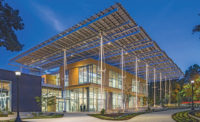Council on Tall Buildings' Experts Call for More-Sustainable High-Rises

Current and past chairmen of the Council on Tall Buildings and Urban Habitat muse over the future of tall buildings. From l. to r., Current CTBUH chairman, Steve Watts, partner, alinea Cost Consulting with past chairs Leslie E. Robertson, director, See Robertson Structural Engineers; Ron Klemencic, chairman and CEO, Magnusson Klemencic Associates; David Scott, director, Laing O’Rourke; Sang-Dae Kim, emeritus professor, Korea University; David Malott, founder & CEO, AI.; and Tim Johnson, partner, NBBJ.
Courtesy of CTBUH
Tall-buildings experts, who are past chairs of the Council on Tall Buildings and Urban Habitat, are calling for more CTBUH research and development, better tools and greater building team collaboration to make high-rises more sustainable.
“We need a more intensive R&D focus on carbon,” said structural engineer David Scott, director, Laing O’Rourke, at the CTBUH’s Tenth World Congress, held Oct. 28-30 in Chicago. “What is the price we are paying in carbon, especially those towers that have heavier structures because of design constraints? We need the metrics to build sustainably,” Scott added.
Architect David Malott, founder & CEO, AI, agreed. “We must learn to build densely more sustainably,” he said at the conference, which drew 1,376 registrants. Technology, for example 3D-printed structures, can be harnessed to help solve problems, especially related to carbon, said Malott.
Disseminate Performance Metrics
Architect Tim Johnson, an NBBJ partner, wants the council to set targets for carbon in high-rises and to disseminate performance metrics of tall buildings, perhaps anonymously, so that others can learn how to improve sustainable design.
Tall buildings enthusiasts boast that high-rises are more sustainable in terms of land use and population density, when compared to suburban developments. But “there is no clarity whether urban density is truly energy efficient,” especially because of a lack of decent urban transportation and other infrastructure, especially in some densely populated cities, said structural engineer Ron Klemencic, chairman and CEO of Magnusson Klemencic Associates. “Western countries are terribly inept at infrastructure microzonation—creating zones for more-efficient locally generated or districtwide power, water and wastewater treatment.
A big challenge is determining the law of diminishing returns for height and density. For each project, there is a sweet spot for tall building height and maximum sustainability, after which greater height reduces sustainability, said Antony Wood, CTBUH’s executive director.
Wood intends to help tall building teams find out what that height is for each project. He is raising funds to create a CTBUH digital tool that would determine the most sustainable height for a tower, based on its many characteristics, including configuration, size, site, locale, economics, materials and more. Wood hopes the R&D project, which he estimates would cost several million dollars and involve all the tall-building disciplines, would start in a year. It would take at least two years to complete.
In terms of the two main framing materials for high-rises, a composite structure of concrete and steel is the most sustainable, according to the results of a recent CTBUH life cycle analysis study comparing the embodied carbon of structural steel and reinforced concrete.
Promise for Tall Timber
Wood sees great promise for tall timber high-rises, which many consider the most sustainable framing material--if proper logging is done--because timber sequesters carbon. “It’s potentially a game-changer,” he says.
High-rises are the key to solving the affordable housing crisis, said Sang-Dae Kim, emeritus professor, Korea University. Kim is calling for cooperation between architects, engineers and academics to create better models for affordable housing.
Leslie E. Robertson, director, See Robertson Structural Engineers, said designers are challenged by cities’ regulations, which are “difficult to work with, often unnecessary and add to cost.”
At the CTBUH meeting, the current CTBUH chair, Steve Watts, partner, in cost consultant alinea Cost Consulting and the past chairs, mused over the mission of the group going forward. The council, which has long collected and disseminated information on best practices around tall building design and construction, is in a unique position to influence lawmakers, building officials and developers and advocate for better tall buildings and urban habitat, they agreed. Toward this, there is a need for a more robust dialogue with policymakers. And there is a need for cross-pollination even among the members of the council, who represent all those involved in the production of tall buildings, including the suppliers of building systems.
Major Growth
CTBUH has experienced major growth since 2006, when Wood became executive director, and there were two employees, including Wood. Today, there are 47 employees--39 full-time and seven part-time--in offices in Chicago, Shanghai and Venice, Italy.
The group currently has 727 organizational members, compared to 449 in 2014. It has 679 individual members, compared to 506 in 2014. There are 13 chapters around the globe, except for Africa.
Though he would not be specific, Wood says the CTBUH has a healthy financial cushion to carry it through any downturn in the construction market. “If there was a recession, we wouldn’t have to panic and lay off staff,” he says, adding that the council grew in the Great Recession.








